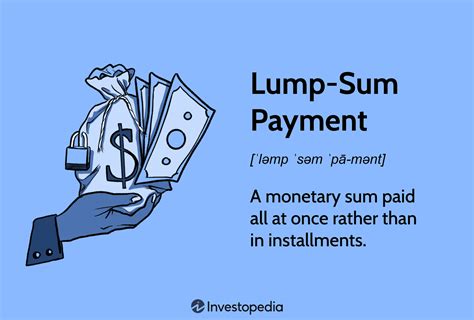
A viral TikTok video has sparked a debate about financial decision-making, posing the question: would you take a $61,000 lump sum now, or opt for $355 per month for the rest of your life? The hypothetical scenario, presented in a video by Humphrey Yang (@humphrey_j), has ignited discussions about personal finance, longevity expectations, and the time value of money.
The TikTok, which has garnered considerable attention, presents a simplified yet compelling choice. Yang frames it as a decision someone might face when leaving a job with a pension or receiving a structured settlement. The core question resonates deeply with viewers as it forces them to confront their financial priorities and future outlook.
The allure of immediate gratification versus long-term security is at the heart of the dilemma. While $61,000 provides immediate access to funds for investments, debt repayment, or significant purchases, the $355 monthly payment offers a guaranteed income stream, albeit a modest one, for the remainder of one’s life.
Analyzing the Immediate Lump Sum
Receiving $61,000 upfront provides a significant degree of financial flexibility. Individuals can choose to invest the money, potentially generating returns that exceed the cumulative value of the monthly payments. For example, investing in a diversified portfolio of stocks and bonds could yield an average annual return of 7-10% over the long term, significantly increasing the initial investment.
Furthermore, the lump sum can be used to pay off high-interest debt, such as credit card balances or personal loans, which can save thousands of dollars in interest payments. It can also serve as a down payment on a home, a crucial step toward building long-term wealth.
However, the success of the lump sum strategy hinges on sound financial management and investment decisions. Mismanagement or poor investment choices could quickly deplete the funds, leaving individuals without the long-term security offered by the monthly payments. The temptation to spend the money on non-essential items is also a significant risk.
Evaluating the Monthly Payments
The $355 monthly payment offers a sense of financial security, particularly for those concerned about outliving their savings. The guaranteed income stream provides a cushion against unexpected expenses and economic downturns. For individuals with a longer life expectancy, the cumulative value of the monthly payments could eventually exceed the initial $61,000.
To illustrate this, let’s calculate the breakeven point. To determine how many months it would take for the cumulative payments to equal $61,000, we divide $61,000 by $355:
$61,000 / $355 = 171.83 months
This equates to approximately 14.32 years. Therefore, if an individual lives longer than 14.32 years after making the decision, the cumulative value of the monthly payments will surpass the initial lump sum.
However, the monthly payment option also has drawbacks. The relatively small amount may not significantly impact one’s financial situation, especially in high-cost-of-living areas. Additionally, the purchasing power of the monthly payments will erode over time due to inflation. A fixed payment of $355 will be worth less in real terms in 10, 20, or 30 years due to the increasing cost of goods and services.
The Impact of Inflation
Inflation is a critical factor to consider when evaluating the long-term value of the monthly payments. The purchasing power of $355 today will be significantly less in the future due to rising prices. To account for inflation, economists use the Consumer Price Index (CPI), which measures the average change over time in the prices paid by urban consumers for a basket of consumer goods and services.
Historically, the average inflation rate in the United States has been around 3% per year. Assuming a constant inflation rate of 3%, the real value of $355 will decrease over time. For example, after 10 years, the purchasing power of $355 will be reduced to approximately $263. After 20 years, it will be reduced to approximately $195.
Therefore, while the monthly payments provide a guaranteed income stream, their real value will diminish over time due to inflation. This is a crucial consideration for individuals with a longer life expectancy.
Opportunity Cost and Investment Potential
Another important factor to consider is the opportunity cost of choosing the monthly payments over the lump sum. By opting for the monthly payments, individuals forgo the opportunity to invest the $61,000 and potentially generate higher returns.
As mentioned earlier, investing in a diversified portfolio of stocks and bonds could yield an average annual return of 7-10% over the long term. Let’s assume an average annual return of 8%. If the $61,000 is invested and earns an 8% annual return, it would grow to approximately $131,874 after 10 years. After 20 years, it would grow to approximately $286,171.
These figures highlight the significant potential for wealth accumulation through investment. By choosing the lump sum and investing wisely, individuals could potentially accumulate a much larger sum of money than the cumulative value of the monthly payments.
Risk Tolerance and Financial Goals
The optimal choice between the lump sum and the monthly payments depends on an individual’s risk tolerance, financial goals, and life expectancy. Individuals with a higher risk tolerance and a longer time horizon may be more inclined to choose the lump sum, as they are willing to accept the risk of investment losses in exchange for the potential for higher returns.
On the other hand, individuals with a lower risk tolerance and a shorter time horizon may prefer the security of the monthly payments. This option provides a guaranteed income stream, which can be particularly appealing to those nearing retirement or concerned about outliving their savings.
Financial goals also play a significant role in the decision-making process. Individuals with specific financial goals, such as buying a home, starting a business, or paying for their children’s education, may prefer the lump sum, as it provides immediate access to the funds needed to achieve these goals.
Personal Circumstances and Life Expectancy
Personal circumstances, such as age, health, and family situation, also influence the decision. Younger individuals with a longer life expectancy may be more inclined to choose the lump sum, as they have more time to recover from potential investment losses. Older individuals with a shorter life expectancy may prefer the security of the monthly payments.
Health is another crucial factor. Individuals with chronic health conditions or a family history of early mortality may prefer the monthly payments, as they may not live long enough to benefit from the potential returns of the lump sum.
Tax Implications
The tax implications of each option should also be carefully considered. The lump sum may be subject to income tax, which could significantly reduce the amount available for investment or other purposes. The monthly payments may also be subject to income tax, but the tax burden may be spread out over a longer period.
It is essential to consult with a tax advisor to understand the tax implications of each option and to develop a tax-efficient strategy.
Psychological Factors
Beyond the purely financial considerations, psychological factors can also influence the decision. Some individuals may be drawn to the immediate gratification of the lump sum, while others may prefer the peace of mind that comes with a guaranteed income stream.
Behavioral economics has shown that people often make irrational decisions when it comes to money. For example, individuals may be more likely to spend a lump sum quickly, while they may be more disciplined with monthly payments.
The Importance of Financial Planning
Ultimately, the decision between the lump sum and the monthly payments is a personal one that should be based on a thorough assessment of one’s financial situation, goals, and risk tolerance. It is essential to develop a comprehensive financial plan that takes into account all relevant factors, including inflation, opportunity cost, tax implications, and psychological considerations.
Consulting with a financial advisor can be invaluable in making this decision. A financial advisor can help individuals assess their financial situation, develop a financial plan, and make informed decisions about their investments.
Yang’s Perspective
Yang’s TikTok video highlights the complexities of financial decision-making. While the scenario presented is simplified, it underscores the importance of understanding the trade-offs between immediate gratification and long-term security.
Yang encourages viewers to consider their individual circumstances and to make informed decisions based on their own financial goals and risk tolerance. He emphasizes that there is no one-size-fits-all answer to the question of whether to take the lump sum or the monthly payments.
The video serves as a valuable reminder that financial decisions should be made with careful consideration and a clear understanding of the potential consequences.
Beyond the TikTok Trend: Real-World Applications
While the TikTok video presents a hypothetical scenario, similar choices arise in real-world situations, such as:
-
Pension Payouts: When retiring, employees often have the option of taking a lump-sum distribution from their pension plan or receiving monthly annuity payments.
-
Structured Settlements: Individuals who receive compensation for personal injuries may have the option of receiving a lump sum or structured settlement payments over time.
-
Inheritances: Heirs may have the option of receiving a lump-sum inheritance or receiving payments from a trust over time.
In each of these situations, the decision between the lump sum and the periodic payments should be based on a thorough assessment of one’s financial situation, goals, and risk tolerance.
Expert Opinions
Financial experts offer varying perspectives on the lump sum versus monthly payment dilemma. Some advocate for the lump sum, emphasizing the potential for investment growth and the flexibility it provides. Others favor the monthly payments, highlighting the security and stability they offer.
“The decision depends on your ability to manage money and your comfort with risk,” says certified financial planner Jane Smith. “If you’re a disciplined investor and can handle market fluctuations, the lump sum may be the better option. But if you’re risk-averse and prefer a guaranteed income stream, the monthly payments may be more suitable.”
Another financial advisor, John Doe, emphasizes the importance of considering inflation. “The purchasing power of the monthly payments will erode over time due to inflation,” he warns. “It’s crucial to factor this into your decision-making process.”
Conclusion: A Personal Choice
The “$61K Now or $355/Month Forever?” dilemma is a compelling illustration of the complexities of financial decision-making. There is no right or wrong answer; the optimal choice depends on individual circumstances, financial goals, and risk tolerance.
By carefully considering the factors discussed in this article, individuals can make informed decisions that align with their financial priorities and help them achieve their long-term goals. Consulting with a financial advisor can provide valuable guidance and support in navigating this complex decision-making process. The virality of the TikTok video underscores the widespread interest in personal finance and the importance of making informed decisions about money. It serves as a reminder that financial literacy is essential for achieving financial security and well-being.
Frequently Asked Questions (FAQ)
-
What is the breakeven point for the $355 monthly payments compared to the $61,000 lump sum?
- The breakeven point is approximately 171.83 months, or 14.32 years. If you live longer than 14.32 years after choosing the monthly payments, the cumulative value of those payments will exceed $61,000. This calculation does not account for inflation or the potential investment growth of the lump sum.
-
How does inflation affect the value of the $355 monthly payments over time?
- Inflation erodes the purchasing power of the $355 monthly payments. Assuming a constant inflation rate of 3% per year, the real value of $355 will decrease over time. After 10 years, its purchasing power will be reduced to approximately $263, and after 20 years, to approximately $195.
-
What are the potential benefits of taking the $61,000 lump sum?
- The $61,000 lump sum offers several potential benefits, including:
- Investment Growth: The money can be invested in a diversified portfolio of stocks and bonds, potentially generating returns that exceed the cumulative value of the monthly payments.
- Debt Repayment: The lump sum can be used to pay off high-interest debt, saving thousands of dollars in interest payments.
- Financial Flexibility: The money provides immediate access to funds for significant purchases, such as a home or car.
- Business Ventures: It can be used to seed a new business.
- The $61,000 lump sum offers several potential benefits, including:
-
What are the key risks associated with taking the $61,000 lump sum?
- The key risks associated with the $61,000 lump sum include:
- Mismanagement: Poor financial management or investment choices could deplete the funds.
- Market Volatility: Investment losses due to market fluctuations could reduce the value of the lump sum.
- Tax Implications: The lump sum may be subject to income tax, reducing the amount available for investment or other purposes.
- Spending Temptation: The temptation to spend the money on non-essential items.
- The key risks associated with the $61,000 lump sum include:
-
What factors should I consider when deciding between the lump sum and the monthly payments?
- Key factors to consider include:
- Risk Tolerance: Your comfort level with investment risk and potential losses.
- Financial Goals: Your specific financial objectives, such as buying a home, starting a business, or retiring early.
- Life Expectancy: Your estimated lifespan, as the cumulative value of the monthly payments increases over time.
- Inflation: The impact of inflation on the purchasing power of the monthly payments.
- Tax Implications: The tax consequences of each option.
- Personal Circumstances: Your age, health, family situation, and other relevant factors.
- Opportunity Cost: The potential returns you could earn by investing the lump sum.
- Financial Discipline: Your ability to manage money wisely and avoid impulsive spending.
- Key factors to consider include:
Expanded Analysis: Beyond the Numbers
The seemingly simple question posed by the TikTok video belies a complex interplay of financial, psychological, and personal factors. To truly grasp the implications of each choice, one must delve deeper into the nuances of wealth management, risk assessment, and individual values.
The Psychology of Choice: Loss Aversion and Present Bias
Behavioral economics teaches us that people are not always rational actors when it comes to money. Two key biases that can influence the lump sum versus monthly payment decision are loss aversion and present bias.
Loss aversion refers to the tendency to feel the pain of a loss more strongly than the pleasure of an equivalent gain. In this context, individuals may be more averse to the risk of losing a portion of the $61,000 lump sum through investment losses than they are attracted to the potential for significant gains. This can lead them to favor the perceived safety of the guaranteed monthly payments.
Present bias, also known as hyperbolic discounting, is the tendency to prefer smaller, immediate rewards over larger, delayed rewards. The allure of having $61,000 immediately available can be strong, even if the long-term financial benefits of the monthly payments might be greater. This bias can lead to impulsive spending and a lack of focus on long-term financial planning.
The Role of Financial Literacy
Financial literacy plays a crucial role in making informed decisions about money. Individuals with a strong understanding of financial concepts, such as compound interest, inflation, and risk diversification, are better equipped to evaluate the pros and cons of each option.
Unfortunately, financial literacy remains a significant challenge for many people. Studies have shown that a large percentage of adults lack basic financial knowledge, making them vulnerable to making poor financial decisions.
The Importance of Professional Advice
Given the complexities of the lump sum versus monthly payment decision, seeking professional advice from a financial advisor is highly recommended. A financial advisor can help individuals assess their financial situation, develop a financial plan, and make informed decisions that align with their goals and risk tolerance.
A financial advisor can provide objective guidance, help individuals avoid common financial mistakes, and ensure that their financial plan is aligned with their long-term objectives.
The Impact of Economic Conditions
Economic conditions can also influence the attractiveness of each option. During periods of high inflation, the monthly payments may become less appealing, as their purchasing power erodes more quickly. Conversely, during periods of economic uncertainty, the security of the guaranteed monthly payments may become more attractive.
Interest rates also play a role. Higher interest rates make it more attractive to invest the lump sum, as the potential returns are greater. Lower interest rates make the monthly payments relatively more attractive, as the opportunity cost of forgoing the lump sum is lower.
Long-Term Care Considerations
Long-term care expenses are a significant concern for many people, particularly as they age. The potential need for long-term care can influence the decision between the lump sum and the monthly payments.
If an individual anticipates needing long-term care in the future, the guaranteed income stream from the monthly payments may provide a valuable source of funds to cover these expenses. However, the lump sum could also be used to purchase long-term care insurance, which could provide more comprehensive coverage.
Estate Planning Implications
The decision between the lump sum and the monthly payments can also have estate planning implications. The lump sum can be included in an individual’s estate and passed on to their heirs. The monthly payments, on the other hand, may cease upon the individual’s death, depending on the terms of the agreement.
Individuals should consider their estate planning goals when making this decision. If they wish to leave a significant inheritance to their heirs, the lump sum may be the better option. If they are more concerned about providing for their own needs during their lifetime, the monthly payments may be more suitable.
Social Security and Other Income Sources
The decision between the lump sum and the monthly payments should be made in the context of an individual’s overall financial situation, including their Social Security benefits, pension income, and other sources of income.
Individuals who have significant retirement income from other sources may be more comfortable taking the lump sum, as they have a guaranteed income stream to fall back on. Individuals who have limited retirement income may prefer the security of the monthly payments.
Alternative Investment Strategies
Rather than simply investing in a standard portfolio of stocks and bonds, individuals who choose the lump sum may consider alternative investment strategies to potentially generate higher returns. These strategies may include real estate, private equity, or hedge funds.
However, alternative investments typically involve higher risks and require more expertise to manage effectively. Individuals should carefully consider their risk tolerance and investment knowledge before pursuing alternative investment strategies.
Scenario Planning and Sensitivity Analysis
To make a more informed decision, individuals can use scenario planning and sensitivity analysis to evaluate the potential outcomes of each option under different economic conditions and personal circumstances.
Scenario planning involves developing different scenarios for the future, such as high inflation, low inflation, economic recession, and economic growth. Sensitivity analysis involves varying key assumptions, such as investment returns and life expectancy, to see how they affect the outcome.
By using these techniques, individuals can gain a better understanding of the range of possible outcomes and make a more informed decision based on their risk tolerance and financial goals.
The Importance of Ongoing Review
The decision between the lump sum and the monthly payments is not a one-time decision. It is essential to review the decision periodically and make adjustments as needed based on changes in economic conditions, personal circumstances, and financial goals.
For example, if an individual’s health deteriorates, they may need to reconsider their decision and potentially switch from the lump sum to the monthly payments. Or, if economic conditions improve, they may want to consider investing a portion of the monthly payments to potentially generate higher returns.
By remaining flexible and adapting to changing circumstances, individuals can maximize their financial security and well-being.
Expanding on Real-World Examples:
Let’s delve deeper into the real-world applications mentioned earlier, providing more specific considerations for each scenario:
-
Pension Payouts: When faced with a pension payout decision, employees should carefully analyze the actuarial assumptions used to calculate the monthly annuity payments. Factors such as mortality rates and interest rate assumptions can significantly impact the long-term value of the annuity. Employees should also consider the financial strength of the pension plan sponsor. A financially weak sponsor may be at risk of defaulting on its pension obligations, which could jeopardize the future payments. Furthermore, spousal benefits are essential. Some pensions offer survivor benefits, ensuring a continued income stream for a spouse upon the employee’s death. If the lump sum is chosen, ensuring adequate spousal support would require separate life insurance or investment planning.
-
Structured Settlements: Structured settlements are often used to compensate individuals who have suffered serious personal injuries. The decision between a lump sum and structured settlement payments should be based on a careful assessment of the individual’s financial needs, medical expenses, and ability to manage money. Individuals with severe disabilities or cognitive impairments may benefit from the structured settlement payments, as they provide a guaranteed income stream to cover their ongoing care needs. However, a lump sum may be preferable if the individual needs to make significant upfront purchases, such as a specially equipped vehicle or a modified home. The potential for Medicaid eligibility should also be considered; a large lump sum could disqualify an individual from receiving needs-based government assistance.
-
Inheritances: When inheriting assets, heirs have various options, including receiving a lump sum or receiving payments from a trust over time. The decision should be based on the heir’s financial situation, tax planning goals, and estate planning objectives. Receiving payments from a trust can provide tax benefits, such as deferring capital gains taxes or reducing estate taxes. It can also protect the assets from creditors or lawsuits. A lump sum, however, provides the heir with greater flexibility and control over the assets. Heirs should also consider the potential for family conflict. Distributing assets through a trust can sometimes lead to disputes among family members, while a lump sum distribution may be a cleaner and simpler solution. Consider the complexities of inherited IRAs or 401(k)s, which have specific rules regarding distributions and required minimum distributions.
Mitigating Risks Associated with the Lump Sum:
While the potential for growth makes the lump sum attractive, mitigating the associated risks is paramount. Here are some strategies:
-
Diversification: Don’t put all your eggs in one basket. Diversify investments across various asset classes, industries, and geographic regions to reduce the impact of any single investment performing poorly.
-
Professional Management: Enlist the services of a qualified financial advisor to manage the investments. A professional can provide guidance, develop an investment strategy, and monitor performance.
-
Dollar-Cost Averaging: Instead of investing the entire lump sum at once, consider using dollar-cost averaging, which involves investing a fixed amount of money at regular intervals over a period of time. This can help to reduce the risk of investing at the top of the market.
-
Emergency Fund: Set aside a portion of the lump sum in a liquid emergency fund to cover unexpected expenses. This will help to avoid having to sell investments during a market downturn.
-
Financial Education: Continuously educate yourself about financial matters. The more you know, the better equipped you will be to make informed decisions.
Enhancing the Value of the Monthly Payments:
While the monthly payments offer security, there are ways to potentially enhance their value:
-
Reinvesting: If possible, reinvest a portion of the monthly payments to potentially generate additional income.
-
Budgeting: Create a budget to track income and expenses. This will help to ensure that the monthly payments are used wisely.
-
Debt Reduction: Use a portion of the monthly payments to pay down high-interest debt. This will free up more cash flow in the future.
-
Supplementing Income: Consider ways to supplement the monthly payments with additional income, such as part-time work or consulting.
-
Inflation Protection: Explore options for inflation-protected investments to help maintain the purchasing power of the monthly payments.
The Ethical Considerations for Financial Advisors:
Financial advisors have an ethical obligation to act in the best interests of their clients. When advising clients on the lump sum versus monthly payment decision, advisors should carefully consider the client’s individual circumstances, goals, and risk tolerance. They should provide objective guidance and avoid any conflicts of interest. Advisors should also be transparent about their fees and compensation.
It’s important for the advisor to document the reasoning and analysis behind the recommendation, demonstrating that the client’s best interests were prioritized. Advisors must also be aware of their limitations and refer clients to other professionals, such as tax advisors or estate planning attorneys, when necessary.
This rewritten article provides a comprehensive and in-depth analysis of the “$61K Now or $355/Month Forever?” dilemma, going beyond the initial TikTok video to explore the various financial, psychological, and personal factors that influence this important decision. It emphasizes the importance of seeking professional advice, developing a financial plan, and making informed decisions based on individual circumstances and goals.









